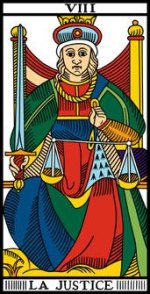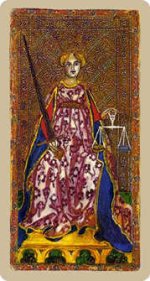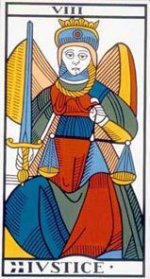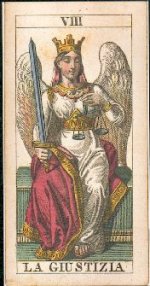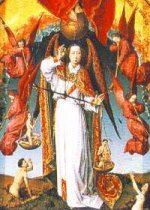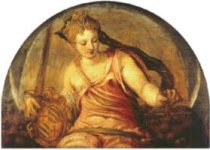jmd
As will undoubtedly be discussed in greater detail by catboxer (or one hopes, anyway!), there are some variations with the numbering occuring in early depictions of the cards.
Variations of numbering, however, have also occured with modern renditions as a result of Waite following Golden Dawn teachings and interchanging the numbering of Justice and Strength - two of the four Cardinal Virtues.
The reason for the interchange is straightforward enough, in that if one follows astrological order, and one also gives these respective cards the attribution of Libra and Leo (attributions definitely not universally accepted), then these should be reversed from their traditional order as Leo precedes Libra. For me, this is not sufficient justification.
Having said this, there are certainly a number of representations of St Michael (or the Archangel Michael) which has been linked to this card through similarity in iconography (sword in right hand, scales in the left). One reason for the scales is straightforward enough, for St Michael's day occurs on the 29th September, in Libra.
The concept of Justice, of course, is quite ancient, and stands independent to the concept of Law. For example, in ancient Greece (as now too, I guess), these two were held to be clearly two different concepts. Justice, or Dikê, implied a straight line, or the custom within a group of people, or the manner in which something is correctly done. Certainly Homer used this term in the Odyssey in these various forms.
As iconography which at times showed the weighing of Souls of the dead, this is found in both Michaelic imagery (again, for example, see p166 of Kaplan's Encyclopedia vol II) and ancient Egyptian iconography. I'm not suggesting that this latter directly influenced the one which later emerged in Tarot, but it would certainly have been known to at least some of the ancient Greek writers and to those influential thinkers blending their various thoughts in that other great aeclectic community - the Alexandrian one.
So what of its consequences? Justice, as Justice rather than Law, is not hoodwinked, but has clarity of vision and thus strives for understanding of the situation in ascertaining the correct action. Reminiscent of both neo-platonic thought and Dostoevski's Crime and Punishment, the Hermetica (X-20) states 'what greater punishment for a human soul [...] than irreverence?'.
Attached is the Camoin 1998 version.
Variations of numbering, however, have also occured with modern renditions as a result of Waite following Golden Dawn teachings and interchanging the numbering of Justice and Strength - two of the four Cardinal Virtues.
The reason for the interchange is straightforward enough, in that if one follows astrological order, and one also gives these respective cards the attribution of Libra and Leo (attributions definitely not universally accepted), then these should be reversed from their traditional order as Leo precedes Libra. For me, this is not sufficient justification.
Having said this, there are certainly a number of representations of St Michael (or the Archangel Michael) which has been linked to this card through similarity in iconography (sword in right hand, scales in the left). One reason for the scales is straightforward enough, for St Michael's day occurs on the 29th September, in Libra.
The concept of Justice, of course, is quite ancient, and stands independent to the concept of Law. For example, in ancient Greece (as now too, I guess), these two were held to be clearly two different concepts. Justice, or Dikê, implied a straight line, or the custom within a group of people, or the manner in which something is correctly done. Certainly Homer used this term in the Odyssey in these various forms.
As iconography which at times showed the weighing of Souls of the dead, this is found in both Michaelic imagery (again, for example, see p166 of Kaplan's Encyclopedia vol II) and ancient Egyptian iconography. I'm not suggesting that this latter directly influenced the one which later emerged in Tarot, but it would certainly have been known to at least some of the ancient Greek writers and to those influential thinkers blending their various thoughts in that other great aeclectic community - the Alexandrian one.
So what of its consequences? Justice, as Justice rather than Law, is not hoodwinked, but has clarity of vision and thus strives for understanding of the situation in ascertaining the correct action. Reminiscent of both neo-platonic thought and Dostoevski's Crime and Punishment, the Hermetica (X-20) states 'what greater punishment for a human soul [...] than irreverence?'.
Attached is the Camoin 1998 version.

